Computer Security System Investigation and Evaluation Project
VerifiedAdded on 2023/02/01
|20
|4395
|42
Project
AI Summary
This project focuses on evaluating the security of a Virtual Machine (VM) image file, simulating a real-world scenario for a company, "Widget Inc." The goal is to assess and improve the security of the VM, Ubuntu 18.04, using VMware Workstation and tools like Kali Linux. The project involves installing the VM, attempting to compromise it through password cracking techniques using Hydra, and then analyzing the security vulnerabilities. The investigation covers various aspects including system hardening, encryption, software updates, and the importance of minimizing system exposure. The project aims to provide a detailed security inspection report, including suggestions for enhancing the system's security posture against threats like data theft, malware, and network vulnerabilities. The student explores methods for securing data, updating software, and mitigating potential risks associated with VM environments.
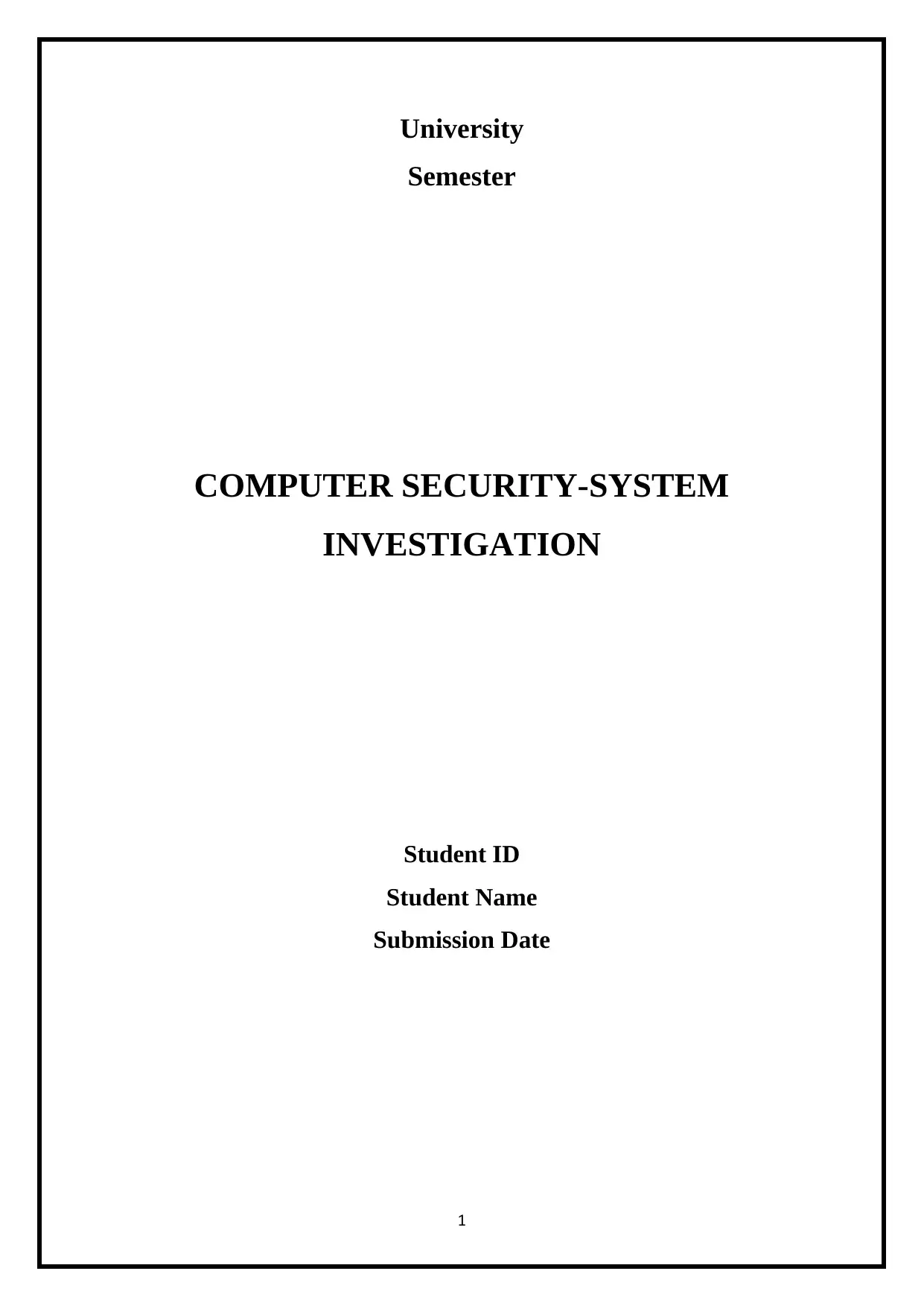
University
Semester
COMPUTER SECURITY-SYSTEM
INVESTIGATION
Student ID
Student Name
Submission Date
1
Semester
COMPUTER SECURITY-SYSTEM
INVESTIGATION
Student ID
Student Name
Submission Date
1
Paraphrase This Document
Need a fresh take? Get an instant paraphrase of this document with our AI Paraphraser
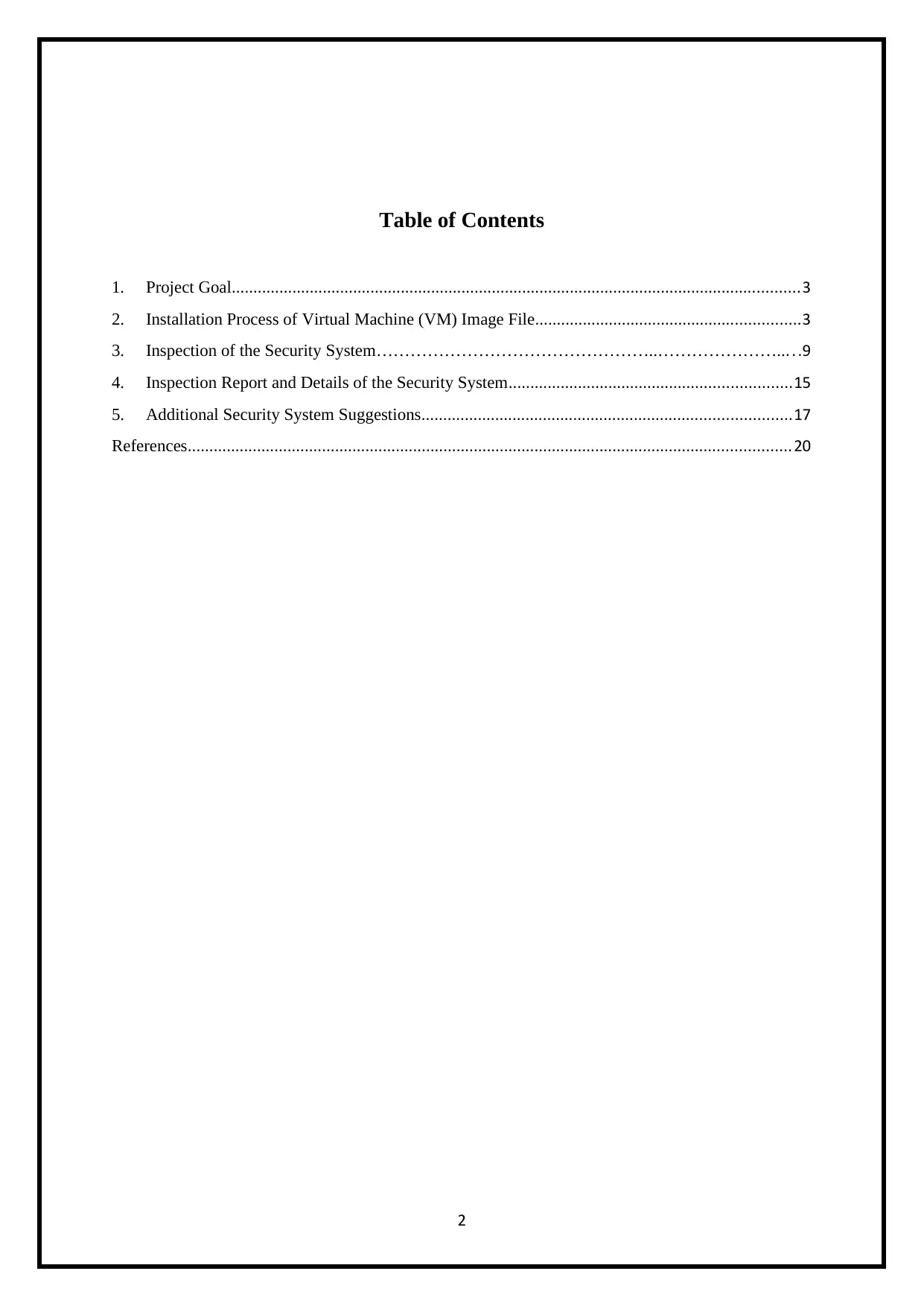
Table of Contents
1. Project Goal...................................................................................................................................3
2. Installation Process of Virtual Machine (VM) Image File.............................................................3
3. Inspection of the Security System…………………………………………..…………………... . .9
4. Inspection Report and Details of the Security System.................................................................15
5. Additional Security System Suggestions.....................................................................................17
References...........................................................................................................................................20
2
1. Project Goal...................................................................................................................................3
2. Installation Process of Virtual Machine (VM) Image File.............................................................3
3. Inspection of the Security System…………………………………………..…………………... . .9
4. Inspection Report and Details of the Security System.................................................................15
5. Additional Security System Suggestions.....................................................................................17
References...........................................................................................................................................20
2
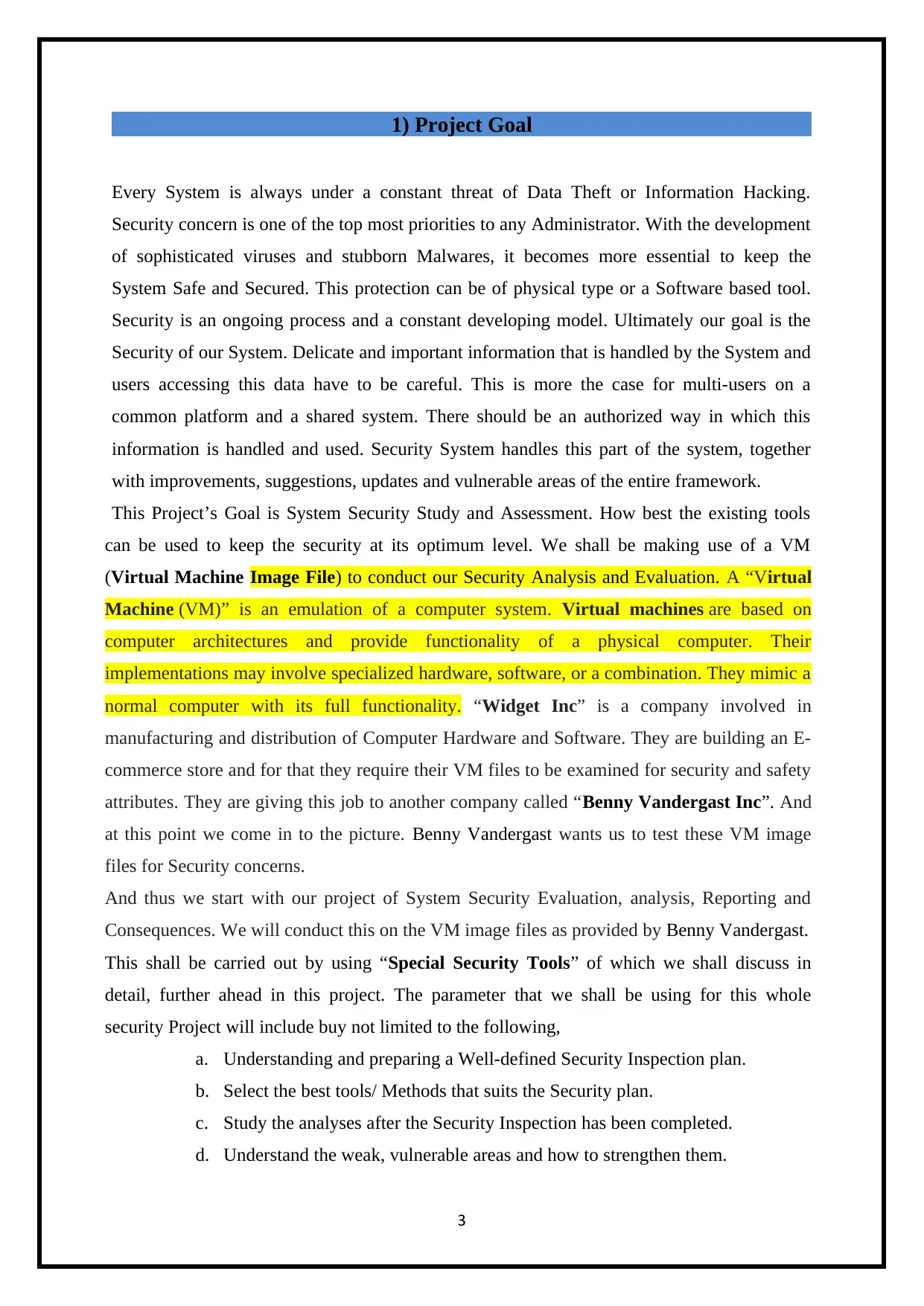
1) Project Goal
Every System is always under a constant threat of Data Theft or Information Hacking.
Security concern is one of the top most priorities to any Administrator. With the development
of sophisticated viruses and stubborn Malwares, it becomes more essential to keep the
System Safe and Secured. This protection can be of physical type or a Software based tool.
Security is an ongoing process and a constant developing model. Ultimately our goal is the
Security of our System. Delicate and important information that is handled by the System and
users accessing this data have to be careful. This is more the case for multi-users on a
common platform and a shared system. There should be an authorized way in which this
information is handled and used. Security System handles this part of the system, together
with improvements, suggestions, updates and vulnerable areas of the entire framework.
This Project’s Goal is System Security Study and Assessment. How best the existing tools
can be used to keep the security at its optimum level. We shall be making use of a VM
(Virtual Machine Image File) to conduct our Security Analysis and Evaluation. A “Virtual
Machine (VM)” is an emulation of a computer system. Virtual machines are based on
computer architectures and provide functionality of a physical computer. Their
implementations may involve specialized hardware, software, or a combination. They mimic a
normal computer with its full functionality. “Widget Inc” is a company involved in
manufacturing and distribution of Computer Hardware and Software. They are building an E-
commerce store and for that they require their VM files to be examined for security and safety
attributes. They are giving this job to another company called “Benny Vandergast Inc”. And
at this point we come in to the picture. Benny Vandergast wants us to test these VM image
files for Security concerns.
And thus we start with our project of System Security Evaluation, analysis, Reporting and
Consequences. We will conduct this on the VM image files as provided by Benny Vandergast.
This shall be carried out by using “Special Security Tools” of which we shall discuss in
detail, further ahead in this project. The parameter that we shall be using for this whole
security Project will include buy not limited to the following,
a. Understanding and preparing a Well-defined Security Inspection plan.
b. Select the best tools/ Methods that suits the Security plan.
c. Study the analyses after the Security Inspection has been completed.
d. Understand the weak, vulnerable areas and how to strengthen them.
3
Every System is always under a constant threat of Data Theft or Information Hacking.
Security concern is one of the top most priorities to any Administrator. With the development
of sophisticated viruses and stubborn Malwares, it becomes more essential to keep the
System Safe and Secured. This protection can be of physical type or a Software based tool.
Security is an ongoing process and a constant developing model. Ultimately our goal is the
Security of our System. Delicate and important information that is handled by the System and
users accessing this data have to be careful. This is more the case for multi-users on a
common platform and a shared system. There should be an authorized way in which this
information is handled and used. Security System handles this part of the system, together
with improvements, suggestions, updates and vulnerable areas of the entire framework.
This Project’s Goal is System Security Study and Assessment. How best the existing tools
can be used to keep the security at its optimum level. We shall be making use of a VM
(Virtual Machine Image File) to conduct our Security Analysis and Evaluation. A “Virtual
Machine (VM)” is an emulation of a computer system. Virtual machines are based on
computer architectures and provide functionality of a physical computer. Their
implementations may involve specialized hardware, software, or a combination. They mimic a
normal computer with its full functionality. “Widget Inc” is a company involved in
manufacturing and distribution of Computer Hardware and Software. They are building an E-
commerce store and for that they require their VM files to be examined for security and safety
attributes. They are giving this job to another company called “Benny Vandergast Inc”. And
at this point we come in to the picture. Benny Vandergast wants us to test these VM image
files for Security concerns.
And thus we start with our project of System Security Evaluation, analysis, Reporting and
Consequences. We will conduct this on the VM image files as provided by Benny Vandergast.
This shall be carried out by using “Special Security Tools” of which we shall discuss in
detail, further ahead in this project. The parameter that we shall be using for this whole
security Project will include buy not limited to the following,
a. Understanding and preparing a Well-defined Security Inspection plan.
b. Select the best tools/ Methods that suits the Security plan.
c. Study the analyses after the Security Inspection has been completed.
d. Understand the weak, vulnerable areas and how to strengthen them.
3
⊘ This is a preview!⊘
Do you want full access?
Subscribe today to unlock all pages.

Trusted by 1+ million students worldwide
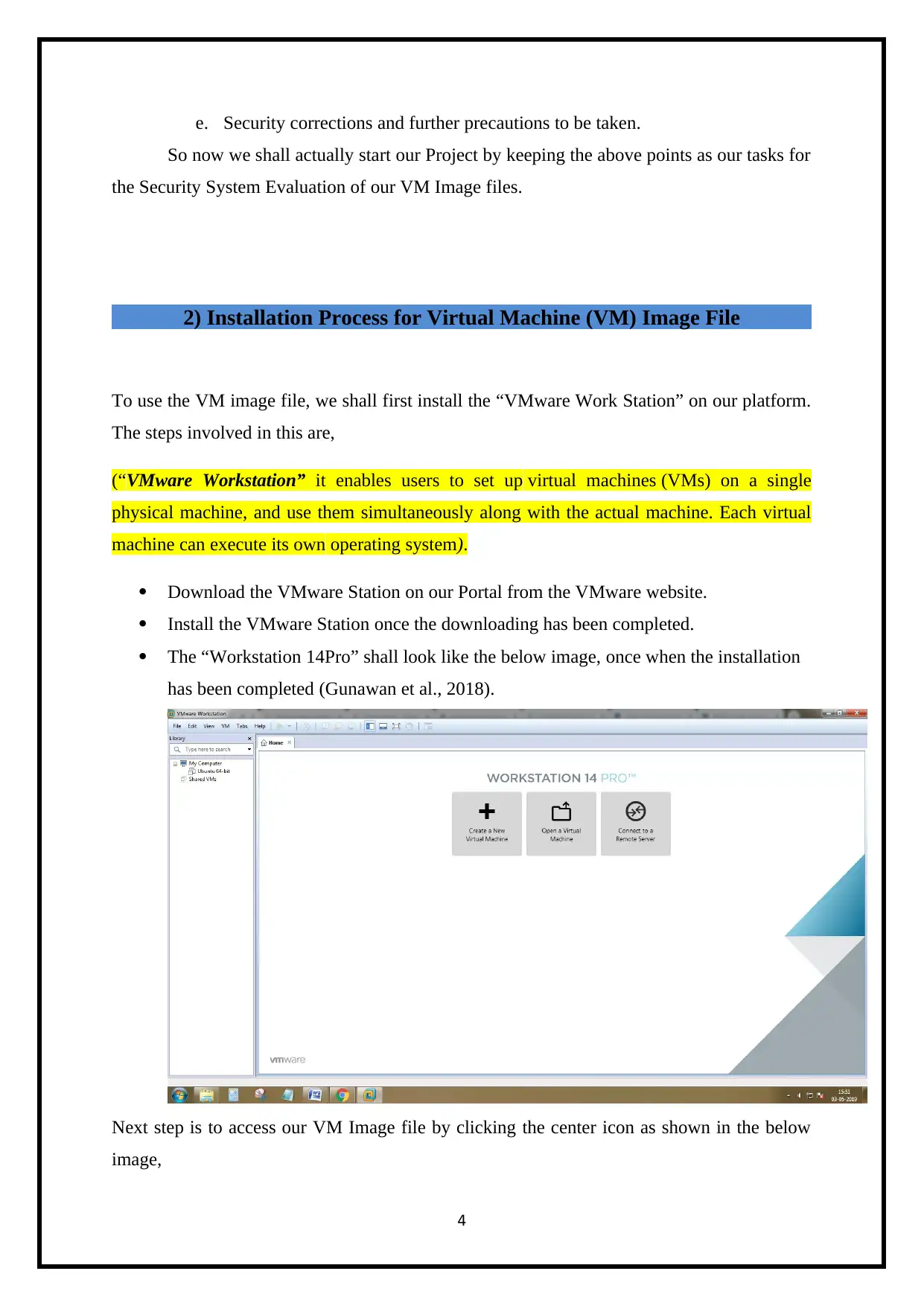
e. Security corrections and further precautions to be taken.
So now we shall actually start our Project by keeping the above points as our tasks for
the Security System Evaluation of our VM Image files.
2) Installation Process for Virtual Machine (VM) Image File
To use the VM image file, we shall first install the “VMware Work Station” on our platform.
The steps involved in this are,
(“VMware Workstation” it enables users to set up virtual machines (VMs) on a single
physical machine, and use them simultaneously along with the actual machine. Each virtual
machine can execute its own operating system).
Download the VMware Station on our Portal from the VMware website.
Install the VMware Station once the downloading has been completed.
The “Workstation 14Pro” shall look like the below image, once when the installation
has been completed (Gunawan et al., 2018).
Next step is to access our VM Image file by clicking the center icon as shown in the below
image,
4
So now we shall actually start our Project by keeping the above points as our tasks for
the Security System Evaluation of our VM Image files.
2) Installation Process for Virtual Machine (VM) Image File
To use the VM image file, we shall first install the “VMware Work Station” on our platform.
The steps involved in this are,
(“VMware Workstation” it enables users to set up virtual machines (VMs) on a single
physical machine, and use them simultaneously along with the actual machine. Each virtual
machine can execute its own operating system).
Download the VMware Station on our Portal from the VMware website.
Install the VMware Station once the downloading has been completed.
The “Workstation 14Pro” shall look like the below image, once when the installation
has been completed (Gunawan et al., 2018).
Next step is to access our VM Image file by clicking the center icon as shown in the below
image,
4
Paraphrase This Document
Need a fresh take? Get an instant paraphrase of this document with our AI Paraphraser
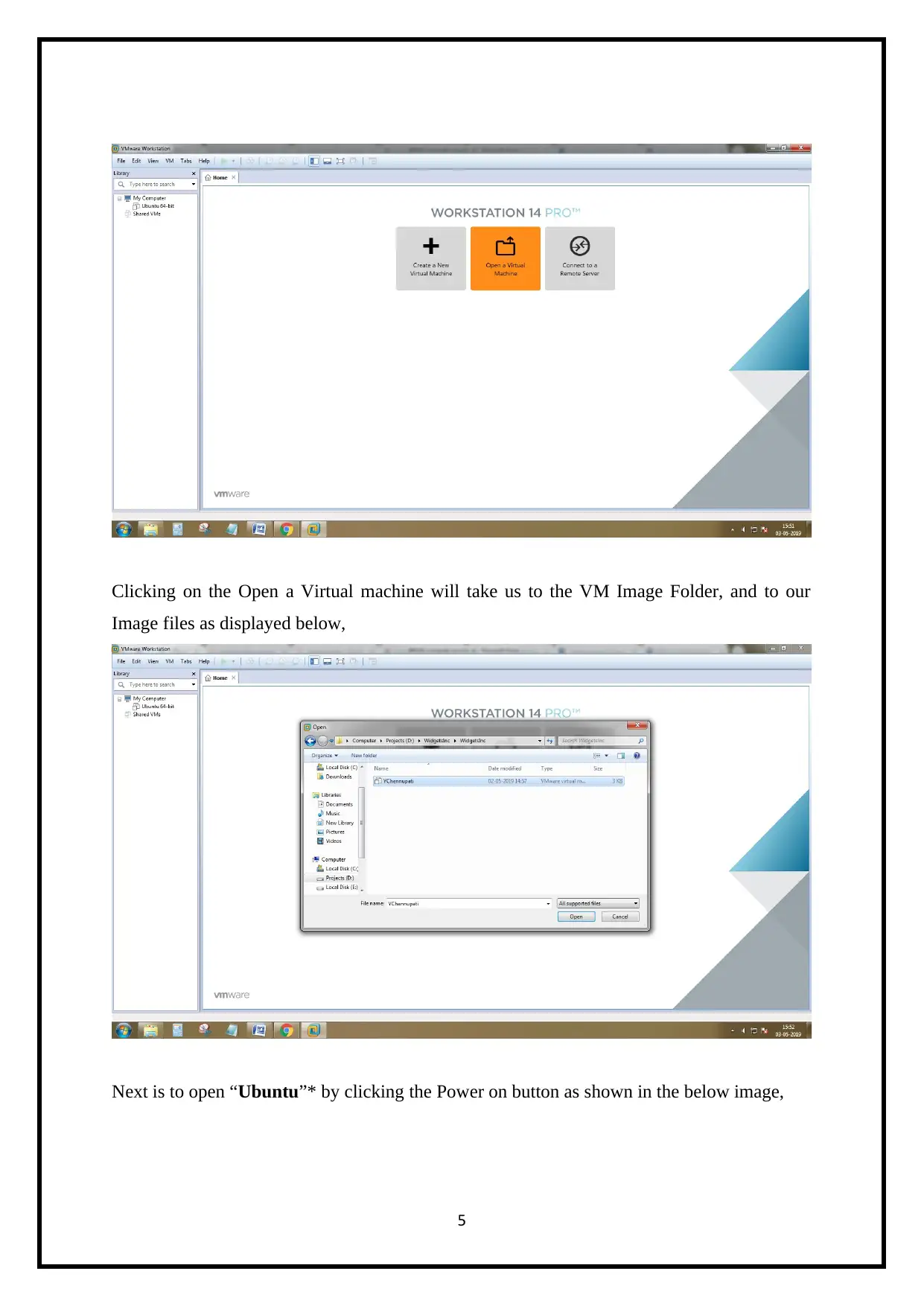
Clicking on the Open a Virtual machine will take us to the VM Image Folder, and to our
Image files as displayed below,
Next is to open “Ubuntu”* by clicking the Power on button as shown in the below image,
5
Image files as displayed below,
Next is to open “Ubuntu”* by clicking the Power on button as shown in the below image,
5
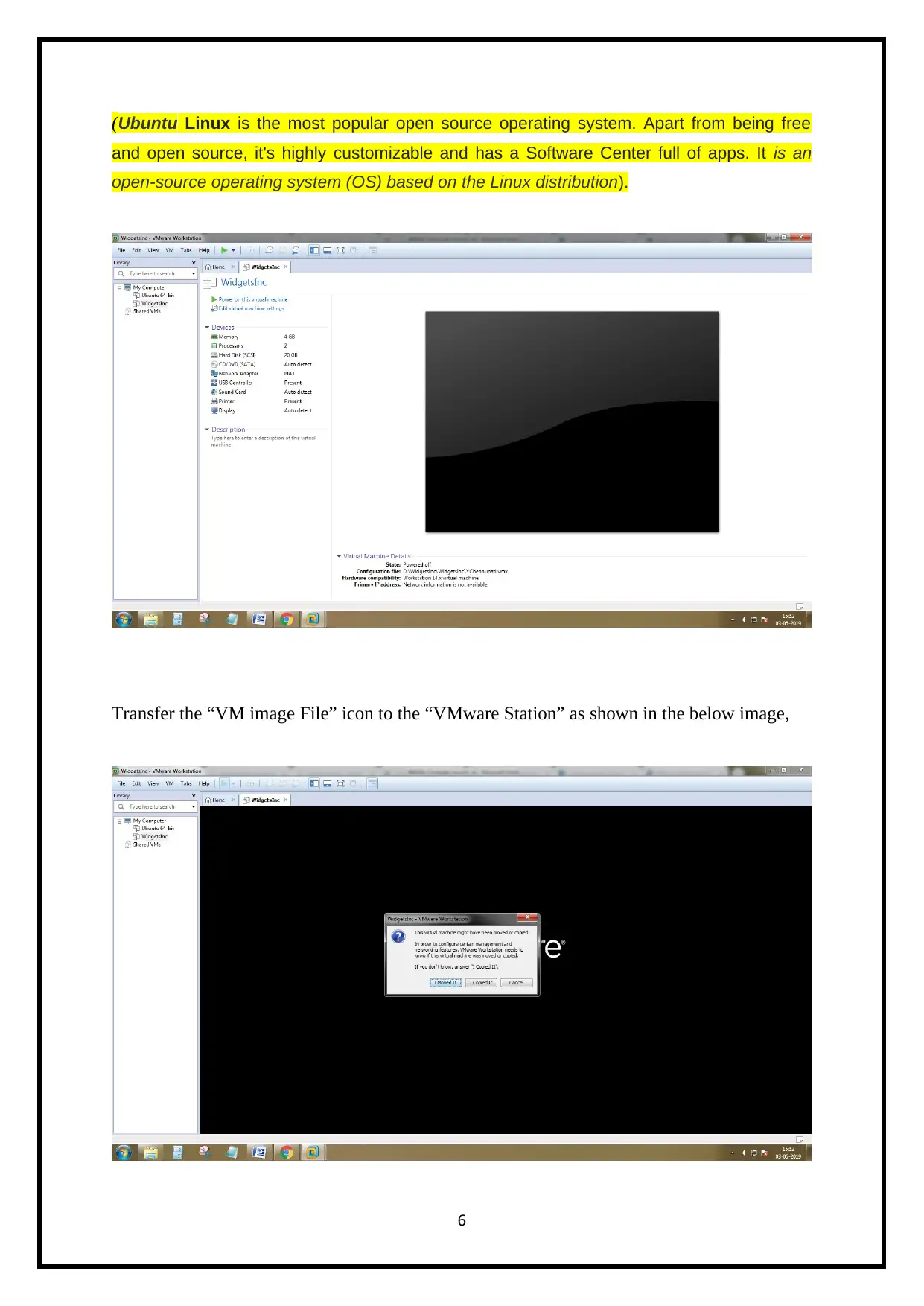
(Ubuntu Linux is the most popular open source operating system. Apart from being free
and open source, it's highly customizable and has a Software Center full of apps. It is an
open-source operating system (OS) based on the Linux distribution).
Transfer the “VM image File” icon to the “VMware Station” as shown in the below image,
6
and open source, it's highly customizable and has a Software Center full of apps. It is an
open-source operating system (OS) based on the Linux distribution).
Transfer the “VM image File” icon to the “VMware Station” as shown in the below image,
6
⊘ This is a preview!⊘
Do you want full access?
Subscribe today to unlock all pages.

Trusted by 1+ million students worldwide
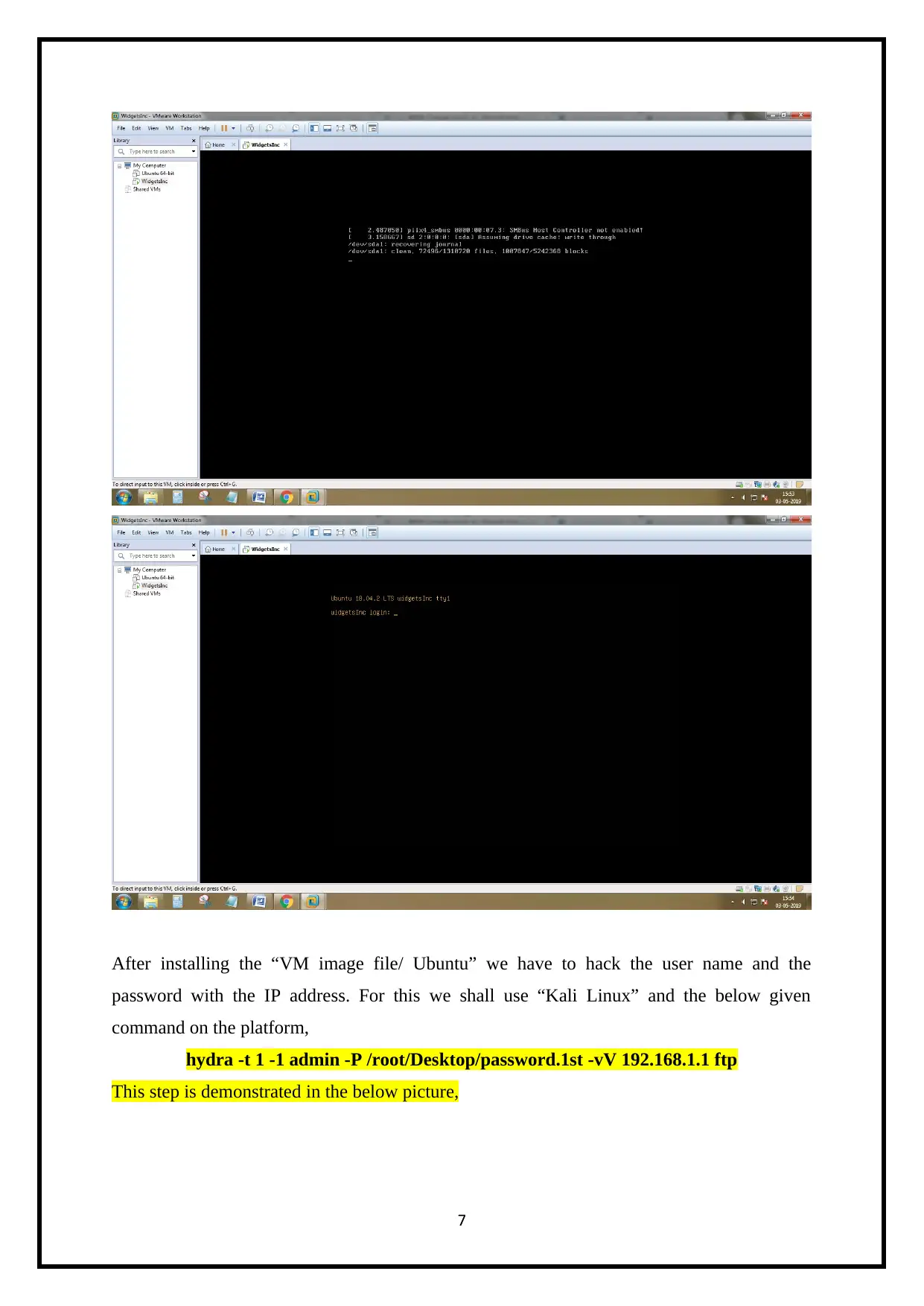
After installing the “VM image file/ Ubuntu” we have to hack the user name and the
password with the IP address. For this we shall use “Kali Linux” and the below given
command on the platform,
hydra -t 1 -1 admin -P /root/Desktop/password.1st -vV 192.168.1.1 ftp
This step is demonstrated in the below picture,
7
password with the IP address. For this we shall use “Kali Linux” and the below given
command on the platform,
hydra -t 1 -1 admin -P /root/Desktop/password.1st -vV 192.168.1.1 ftp
This step is demonstrated in the below picture,
7
Paraphrase This Document
Need a fresh take? Get an instant paraphrase of this document with our AI Paraphraser
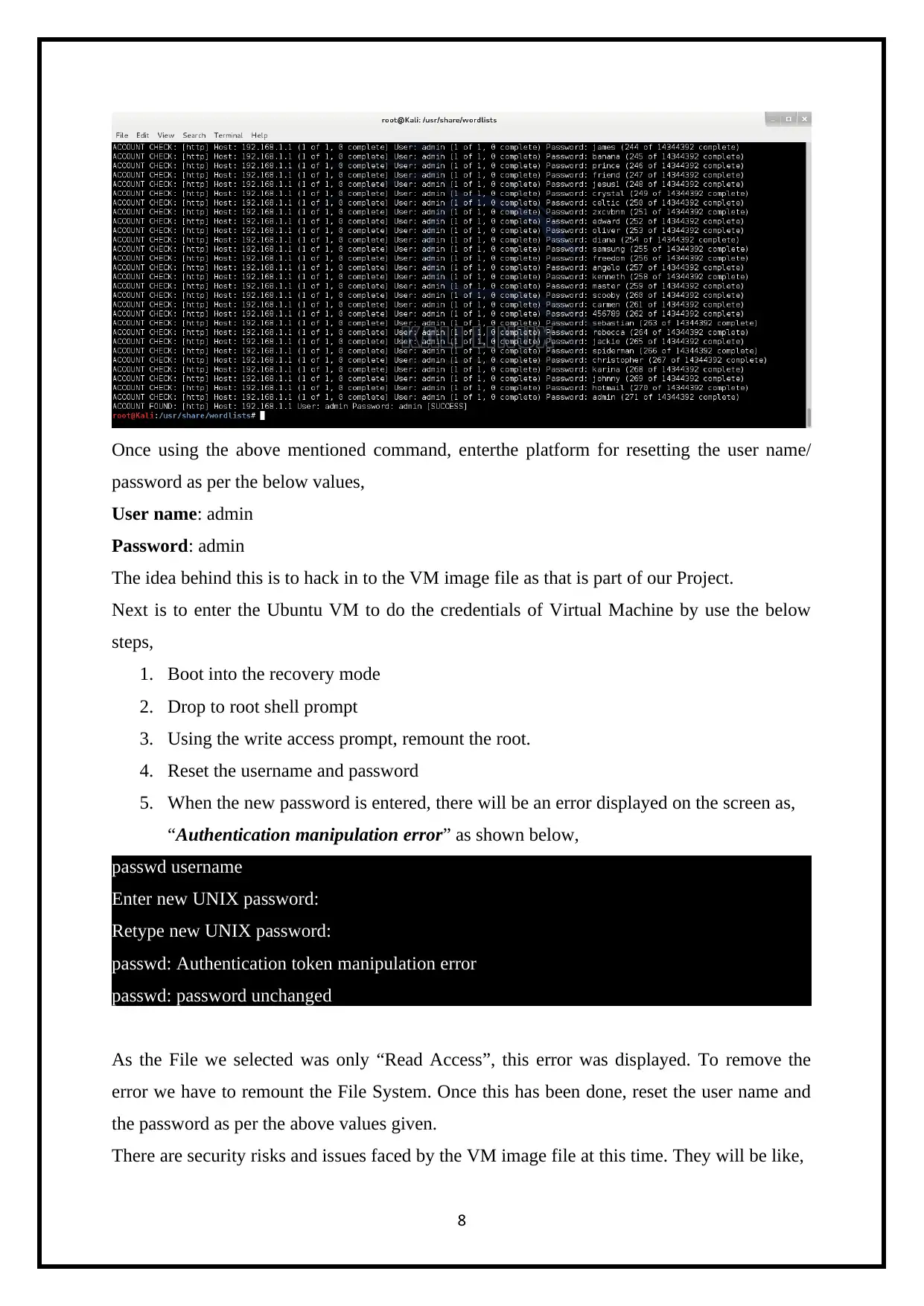
Once using the above mentioned command, enterthe platform for resetting the user name/
password as per the below values,
User name: admin
Password: admin
The idea behind this is to hack in to the VM image file as that is part of our Project.
Next is to enter the Ubuntu VM to do the credentials of Virtual Machine by use the below
steps,
1. Boot into the recovery mode
2. Drop to root shell prompt
3. Using the write access prompt, remount the root.
4. Reset the username and password
5. When the new password is entered, there will be an error displayed on the screen as,
“Authentication manipulation error” as shown below,
passwd username
Enter new UNIX password:
Retype new UNIX password:
passwd: Authentication token manipulation error
passwd: password unchanged
As the File we selected was only “Read Access”, this error was displayed. To remove the
error we have to remount the File System. Once this has been done, reset the user name and
the password as per the above values given.
There are security risks and issues faced by the VM image file at this time. They will be like,
8
password as per the below values,
User name: admin
Password: admin
The idea behind this is to hack in to the VM image file as that is part of our Project.
Next is to enter the Ubuntu VM to do the credentials of Virtual Machine by use the below
steps,
1. Boot into the recovery mode
2. Drop to root shell prompt
3. Using the write access prompt, remount the root.
4. Reset the username and password
5. When the new password is entered, there will be an error displayed on the screen as,
“Authentication manipulation error” as shown below,
passwd username
Enter new UNIX password:
Retype new UNIX password:
passwd: Authentication token manipulation error
passwd: password unchanged
As the File we selected was only “Read Access”, this error was displayed. To remove the
error we have to remount the File System. Once this has been done, reset the user name and
the password as per the above values given.
There are security risks and issues faced by the VM image file at this time. They will be like,
8
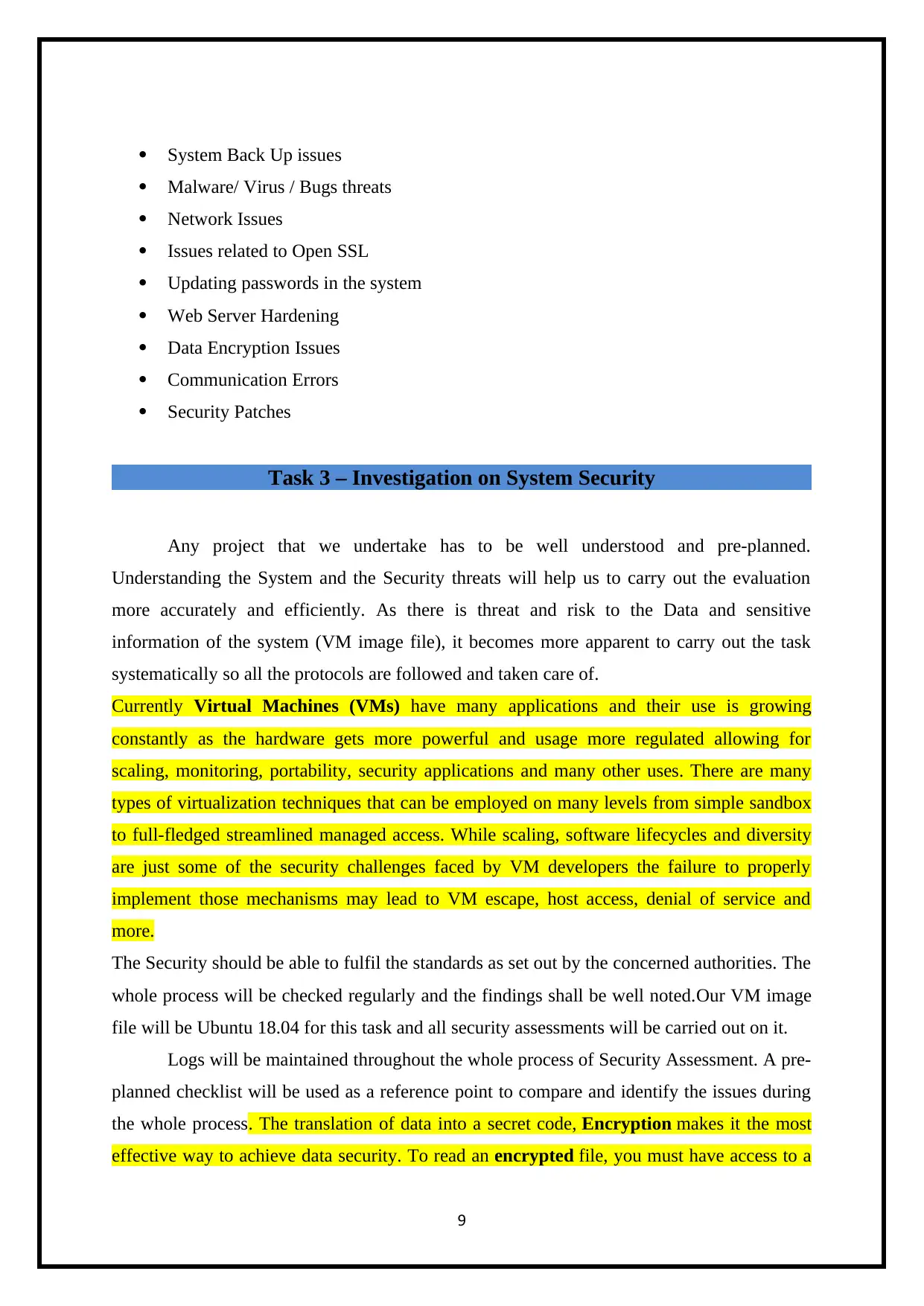
System Back Up issues
Malware/ Virus / Bugs threats
Network Issues
Issues related to Open SSL
Updating passwords in the system
Web Server Hardening
Data Encryption Issues
Communication Errors
Security Patches
Task 3 – Investigation on System Security
Any project that we undertake has to be well understood and pre-planned.
Understanding the System and the Security threats will help us to carry out the evaluation
more accurately and efficiently. As there is threat and risk to the Data and sensitive
information of the system (VM image file), it becomes more apparent to carry out the task
systematically so all the protocols are followed and taken care of.
Currently Virtual Machines (VMs) have many applications and their use is growing
constantly as the hardware gets more powerful and usage more regulated allowing for
scaling, monitoring, portability, security applications and many other uses. There are many
types of virtualization techniques that can be employed on many levels from simple sandbox
to full-fledged streamlined managed access. While scaling, software lifecycles and diversity
are just some of the security challenges faced by VM developers the failure to properly
implement those mechanisms may lead to VM escape, host access, denial of service and
more.
The Security should be able to fulfil the standards as set out by the concerned authorities. The
whole process will be checked regularly and the findings shall be well noted.Our VM image
file will be Ubuntu 18.04 for this task and all security assessments will be carried out on it.
Logs will be maintained throughout the whole process of Security Assessment. A pre-
planned checklist will be used as a reference point to compare and identify the issues during
the whole process. The translation of data into a secret code, Encryption makes it the most
effective way to achieve data security. To read an encrypted file, you must have access to a
9
Malware/ Virus / Bugs threats
Network Issues
Issues related to Open SSL
Updating passwords in the system
Web Server Hardening
Data Encryption Issues
Communication Errors
Security Patches
Task 3 – Investigation on System Security
Any project that we undertake has to be well understood and pre-planned.
Understanding the System and the Security threats will help us to carry out the evaluation
more accurately and efficiently. As there is threat and risk to the Data and sensitive
information of the system (VM image file), it becomes more apparent to carry out the task
systematically so all the protocols are followed and taken care of.
Currently Virtual Machines (VMs) have many applications and their use is growing
constantly as the hardware gets more powerful and usage more regulated allowing for
scaling, monitoring, portability, security applications and many other uses. There are many
types of virtualization techniques that can be employed on many levels from simple sandbox
to full-fledged streamlined managed access. While scaling, software lifecycles and diversity
are just some of the security challenges faced by VM developers the failure to properly
implement those mechanisms may lead to VM escape, host access, denial of service and
more.
The Security should be able to fulfil the standards as set out by the concerned authorities. The
whole process will be checked regularly and the findings shall be well noted.Our VM image
file will be Ubuntu 18.04 for this task and all security assessments will be carried out on it.
Logs will be maintained throughout the whole process of Security Assessment. A pre-
planned checklist will be used as a reference point to compare and identify the issues during
the whole process. The translation of data into a secret code, Encryption makes it the most
effective way to achieve data security. To read an encrypted file, you must have access to a
9
⊘ This is a preview!⊘
Do you want full access?
Subscribe today to unlock all pages.

Trusted by 1+ million students worldwide
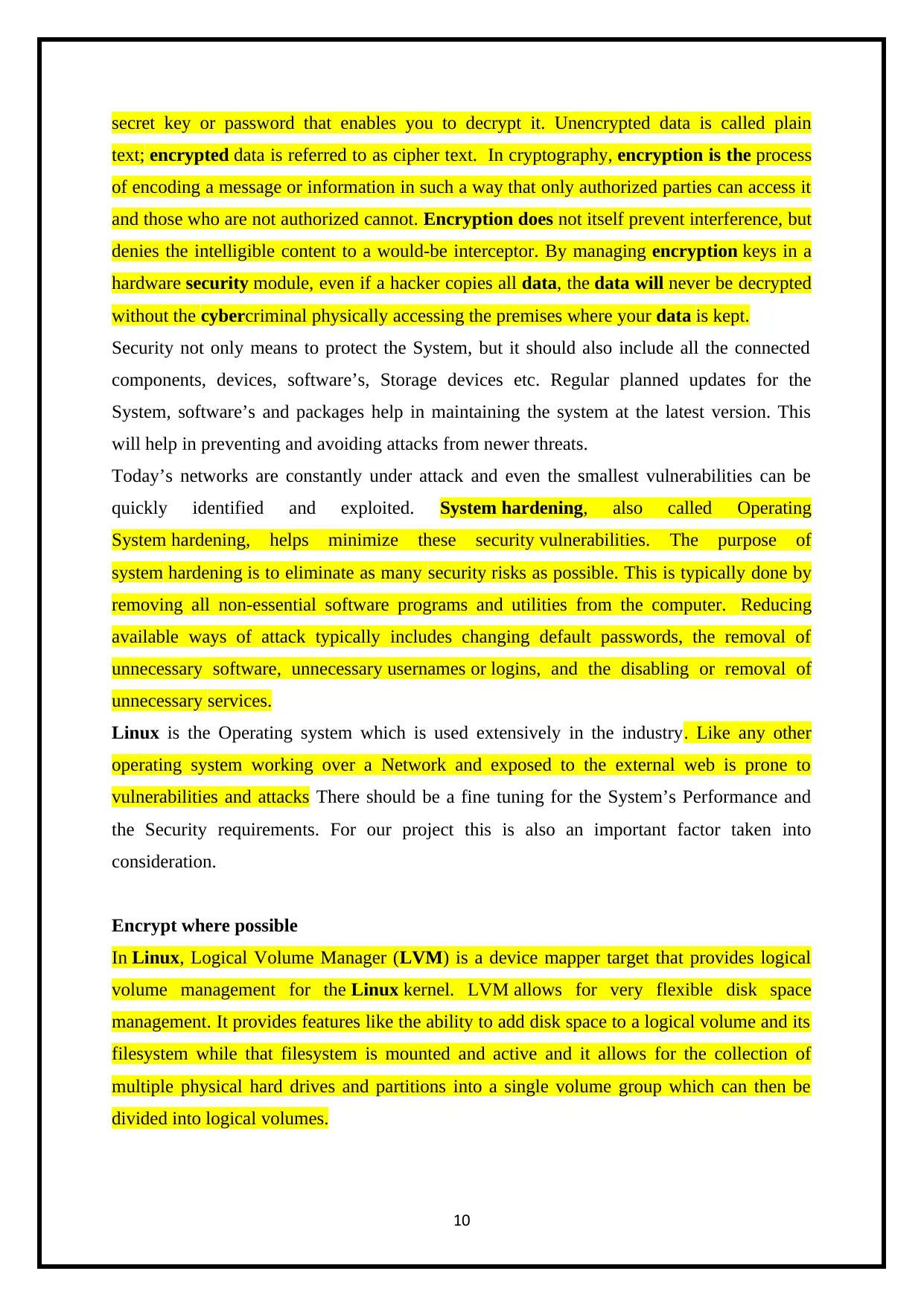
secret key or password that enables you to decrypt it. Unencrypted data is called plain
text; encrypted data is referred to as cipher text. In cryptography, encryption is the process
of encoding a message or information in such a way that only authorized parties can access it
and those who are not authorized cannot. Encryption does not itself prevent interference, but
denies the intelligible content to a would-be interceptor. By managing encryption keys in a
hardware security module, even if a hacker copies all data, the data will never be decrypted
without the cybercriminal physically accessing the premises where your data is kept.
Security not only means to protect the System, but it should also include all the connected
components, devices, software’s, Storage devices etc. Regular planned updates for the
System, software’s and packages help in maintaining the system at the latest version. This
will help in preventing and avoiding attacks from newer threats.
Today’s networks are constantly under attack and even the smallest vulnerabilities can be
quickly identified and exploited. System hardening, also called Operating
System hardening, helps minimize these security vulnerabilities. The purpose of
system hardening is to eliminate as many security risks as possible. This is typically done by
removing all non-essential software programs and utilities from the computer. Reducing
available ways of attack typically includes changing default passwords, the removal of
unnecessary software, unnecessary usernames or logins, and the disabling or removal of
unnecessary services.
Linux is the Operating system which is used extensively in the industry. Like any other
operating system working over a Network and exposed to the external web is prone to
vulnerabilities and attacks There should be a fine tuning for the System’s Performance and
the Security requirements. For our project this is also an important factor taken into
consideration.
Encrypt where possible
In Linux, Logical Volume Manager (LVM) is a device mapper target that provides logical
volume management for the Linux kernel. LVM allows for very flexible disk space
management. It provides features like the ability to add disk space to a logical volume and its
filesystem while that filesystem is mounted and active and it allows for the collection of
multiple physical hard drives and partitions into a single volume group which can then be
divided into logical volumes.
10
text; encrypted data is referred to as cipher text. In cryptography, encryption is the process
of encoding a message or information in such a way that only authorized parties can access it
and those who are not authorized cannot. Encryption does not itself prevent interference, but
denies the intelligible content to a would-be interceptor. By managing encryption keys in a
hardware security module, even if a hacker copies all data, the data will never be decrypted
without the cybercriminal physically accessing the premises where your data is kept.
Security not only means to protect the System, but it should also include all the connected
components, devices, software’s, Storage devices etc. Regular planned updates for the
System, software’s and packages help in maintaining the system at the latest version. This
will help in preventing and avoiding attacks from newer threats.
Today’s networks are constantly under attack and even the smallest vulnerabilities can be
quickly identified and exploited. System hardening, also called Operating
System hardening, helps minimize these security vulnerabilities. The purpose of
system hardening is to eliminate as many security risks as possible. This is typically done by
removing all non-essential software programs and utilities from the computer. Reducing
available ways of attack typically includes changing default passwords, the removal of
unnecessary software, unnecessary usernames or logins, and the disabling or removal of
unnecessary services.
Linux is the Operating system which is used extensively in the industry. Like any other
operating system working over a Network and exposed to the external web is prone to
vulnerabilities and attacks There should be a fine tuning for the System’s Performance and
the Security requirements. For our project this is also an important factor taken into
consideration.
Encrypt where possible
In Linux, Logical Volume Manager (LVM) is a device mapper target that provides logical
volume management for the Linux kernel. LVM allows for very flexible disk space
management. It provides features like the ability to add disk space to a logical volume and its
filesystem while that filesystem is mounted and active and it allows for the collection of
multiple physical hard drives and partitions into a single volume group which can then be
divided into logical volumes.
10
Paraphrase This Document
Need a fresh take? Get an instant paraphrase of this document with our AI Paraphraser
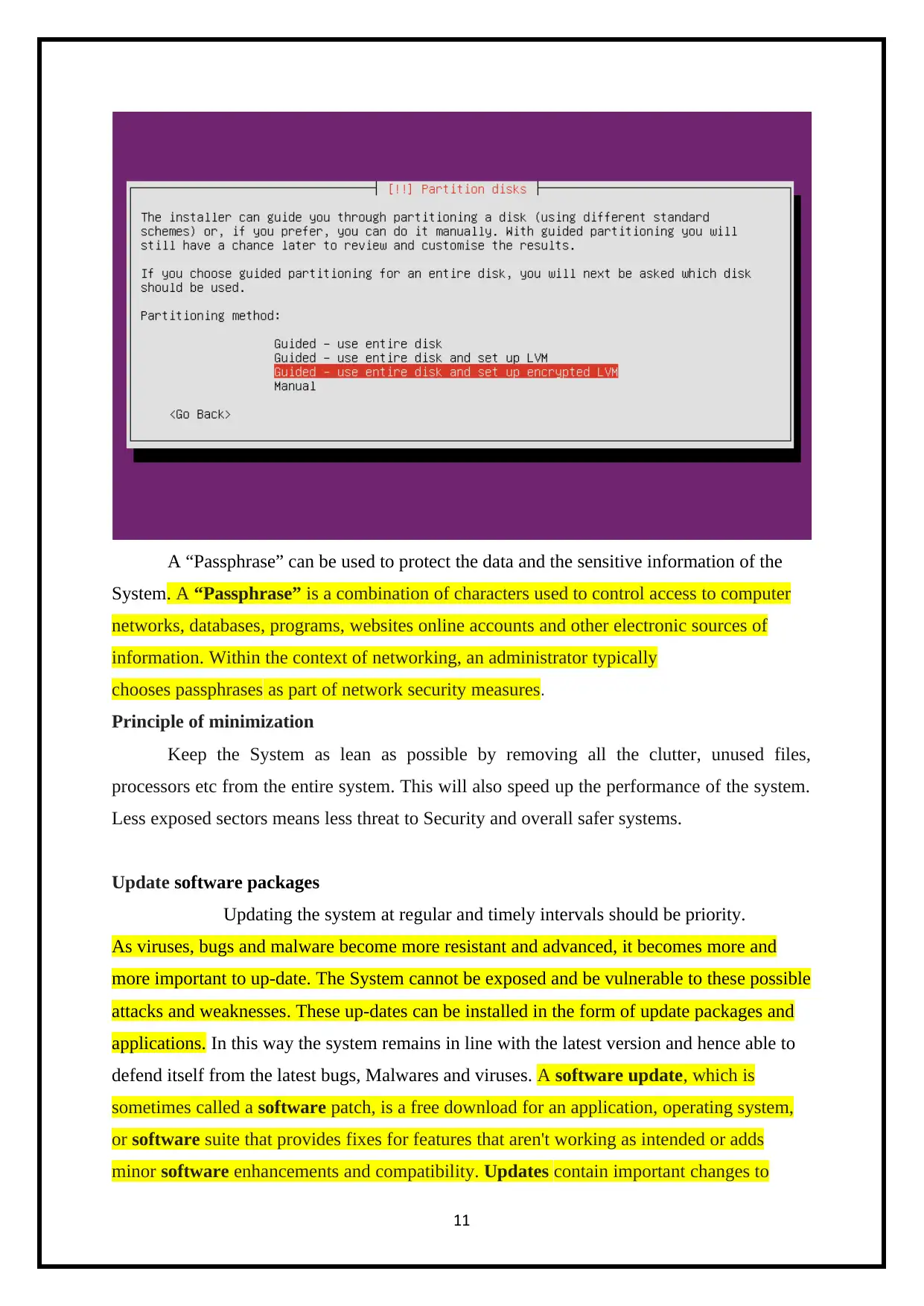
A “Passphrase” can be used to protect the data and the sensitive information of the
System. A “Passphrase” is a combination of characters used to control access to computer
networks, databases, programs, websites online accounts and other electronic sources of
information. Within the context of networking, an administrator typically
chooses passphrases as part of network security measures.
Principle of minimization
Keep the System as lean as possible by removing all the clutter, unused files,
processors etc from the entire system. This will also speed up the performance of the system.
Less exposed sectors means less threat to Security and overall safer systems.
Update software packages
Updating the system at regular and timely intervals should be priority.
As viruses, bugs and malware become more resistant and advanced, it becomes more and
more important to up-date. The System cannot be exposed and be vulnerable to these possible
attacks and weaknesses. These up-dates can be installed in the form of update packages and
applications. In this way the system remains in line with the latest version and hence able to
defend itself from the latest bugs, Malwares and viruses. A software update, which is
sometimes called a software patch, is a free download for an application, operating system,
or software suite that provides fixes for features that aren't working as intended or adds
minor software enhancements and compatibility. Updates contain important changes to
11
System. A “Passphrase” is a combination of characters used to control access to computer
networks, databases, programs, websites online accounts and other electronic sources of
information. Within the context of networking, an administrator typically
chooses passphrases as part of network security measures.
Principle of minimization
Keep the System as lean as possible by removing all the clutter, unused files,
processors etc from the entire system. This will also speed up the performance of the system.
Less exposed sectors means less threat to Security and overall safer systems.
Update software packages
Updating the system at regular and timely intervals should be priority.
As viruses, bugs and malware become more resistant and advanced, it becomes more and
more important to up-date. The System cannot be exposed and be vulnerable to these possible
attacks and weaknesses. These up-dates can be installed in the form of update packages and
applications. In this way the system remains in line with the latest version and hence able to
defend itself from the latest bugs, Malwares and viruses. A software update, which is
sometimes called a software patch, is a free download for an application, operating system,
or software suite that provides fixes for features that aren't working as intended or adds
minor software enhancements and compatibility. Updates contain important changes to
11
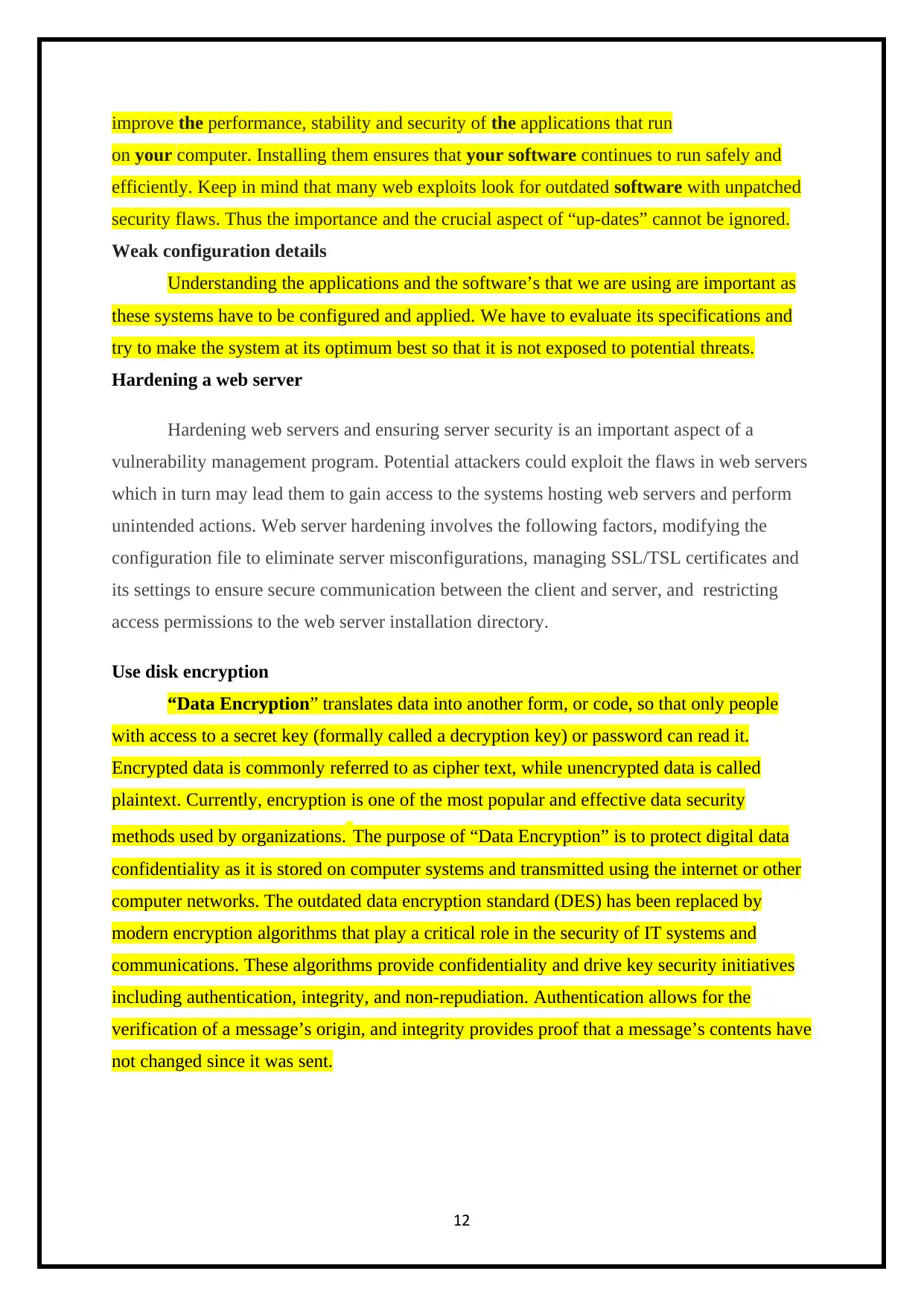
improve the performance, stability and security of the applications that run
on your computer. Installing them ensures that your software continues to run safely and
efficiently. Keep in mind that many web exploits look for outdated software with unpatched
security flaws. Thus the importance and the crucial aspect of “up-dates” cannot be ignored.
Weak configuration details
Understanding the applications and the software’s that we are using are important as
these systems have to be configured and applied. We have to evaluate its specifications and
try to make the system at its optimum best so that it is not exposed to potential threats.
Hardening a web server
Hardening web servers and ensuring server security is an important aspect of a
vulnerability management program. Potential attackers could exploit the flaws in web servers
which in turn may lead them to gain access to the systems hosting web servers and perform
unintended actions. Web server hardening involves the following factors, modifying the
configuration file to eliminate server misconfigurations, managing SSL/TSL certificates and
its settings to ensure secure communication between the client and server, and restricting
access permissions to the web server installation directory.
Use disk encryption
“Data Encryption” translates data into another form, or code, so that only people
with access to a secret key (formally called a decryption key) or password can read it.
Encrypted data is commonly referred to as cipher text, while unencrypted data is called
plaintext. Currently, encryption is one of the most popular and effective data security
methods used by organizations. The purpose of “Data Encryption” is to protect digital data
confidentiality as it is stored on computer systems and transmitted using the internet or other
computer networks. The outdated data encryption standard (DES) has been replaced by
modern encryption algorithms that play a critical role in the security of IT systems and
communications. These algorithms provide confidentiality and drive key security initiatives
including authentication, integrity, and non-repudiation. Authentication allows for the
verification of a message’s origin, and integrity provides proof that a message’s contents have
not changed since it was sent.
12
on your computer. Installing them ensures that your software continues to run safely and
efficiently. Keep in mind that many web exploits look for outdated software with unpatched
security flaws. Thus the importance and the crucial aspect of “up-dates” cannot be ignored.
Weak configuration details
Understanding the applications and the software’s that we are using are important as
these systems have to be configured and applied. We have to evaluate its specifications and
try to make the system at its optimum best so that it is not exposed to potential threats.
Hardening a web server
Hardening web servers and ensuring server security is an important aspect of a
vulnerability management program. Potential attackers could exploit the flaws in web servers
which in turn may lead them to gain access to the systems hosting web servers and perform
unintended actions. Web server hardening involves the following factors, modifying the
configuration file to eliminate server misconfigurations, managing SSL/TSL certificates and
its settings to ensure secure communication between the client and server, and restricting
access permissions to the web server installation directory.
Use disk encryption
“Data Encryption” translates data into another form, or code, so that only people
with access to a secret key (formally called a decryption key) or password can read it.
Encrypted data is commonly referred to as cipher text, while unencrypted data is called
plaintext. Currently, encryption is one of the most popular and effective data security
methods used by organizations. The purpose of “Data Encryption” is to protect digital data
confidentiality as it is stored on computer systems and transmitted using the internet or other
computer networks. The outdated data encryption standard (DES) has been replaced by
modern encryption algorithms that play a critical role in the security of IT systems and
communications. These algorithms provide confidentiality and drive key security initiatives
including authentication, integrity, and non-repudiation. Authentication allows for the
verification of a message’s origin, and integrity provides proof that a message’s contents have
not changed since it was sent.
12
⊘ This is a preview!⊘
Do you want full access?
Subscribe today to unlock all pages.

Trusted by 1+ million students worldwide
1 out of 20
Related Documents
Your All-in-One AI-Powered Toolkit for Academic Success.
+13062052269
info@desklib.com
Available 24*7 on WhatsApp / Email
![[object Object]](/_next/static/media/star-bottom.7253800d.svg)
Unlock your academic potential
Copyright © 2020–2025 A2Z Services. All Rights Reserved. Developed and managed by ZUCOL.





